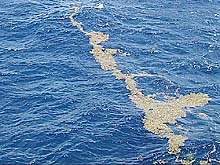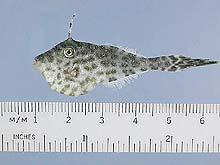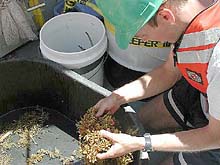
These lines of sargassum can stretch for miles along the surface. The clumps of floating algae are often concentrated by the strong winds and wave action associated with the Gulf Stream. Click image for a larger view.
Sargassum and Open Water Surface Communities
August 09, 2002
Dr. Steve W. Ross
North Carolina National Estuarine Research Reserve, Wilmington, NC
Tara L. Casazza
North Carolina National Estuarine Research Reserve, Wilmington, NC
Dr. Ken J. Sulak
USGS, National Biological Survey, Gainesville, FL
As part of our program to sample all communities throughout the water column during this cruises, we spend considerable time documenting animals at the uppermost surface layer. This layer is in constant motion as a result of waves, but is also constantly moving northward with the Gulf Stream. A unique habitat in these surface waters is the Sargassum community. Sargassum is a floating brown algae and often forms huge rafts that stretch for miles across the ocean. Numerous animals use this floating habitat and some, like the Sargassum fish (in the frogfish family), live their whole lives only in this habitat. This habitat is difficult to sample and has been poorly studied. Apparently, however, it harbors large numbers of juvenile fishes and invertebrates, many of which are camouflaged to match the algae.

A juvenile scrawled filefish (Aluterus scriptus) found within the mass of sargassum. Its cryptic coloring helps it avoid preditors as it lives among the tangled mass of floating algae. This species may grow as long as two to three feet in length. Click image for a larger view.
We use neuston nets to sample the upper meter of the water column. This involves pulling a small mesh frame net for 15 minutes in both open waters and waters containing Sargassum. When weed lines are thick, we also use dip nets and divers with underwater video cameras. We have employed these methods during all of our cruises off North Carolina from Cape Hatteras to Cape Fear.
So far, we have documented 62 fish species that use Sargassum off North Carolina, which is a substantial increase from previous studies. Most of these fishes are in juvenile stages and use the habitat for feeding while taking advantage of it to hide from predators. One of the most common economically important fishes we have sampled was the dolphin fish (or Mahi mahi). Small dolphin fish live very close to the Sargassum, and as they become larger, they patrol in schools underneath the weed lines. Fishermen often look for the weed lines to improve their chances of catching dolphin fish. Amberjacks (and other jacks), filefishes, and trigger fishes are dominant groups in Sargassum. Flying fishes also often take advantage of this floating, mobile complex community.
Our sampling has shown that many species, especially larval forms, occur in the open water (without Sargassum). But Sargassum allows both large numbers of species as well as large numbers of individuals to be concentrated in small areas. The number of individuals that can be supported is directly related to the quantity of algae available.
Our continuing studies of the surface communities off the Carolinas will eventually give us a more complete view of community structure, and we will be investigating the feeding habits of these animals. Only through such knowledge can we adequately manage and protect valuable resources, ensuring their availability for the future.
Sign up for the Ocean Explorer E-mail Update List.
















































